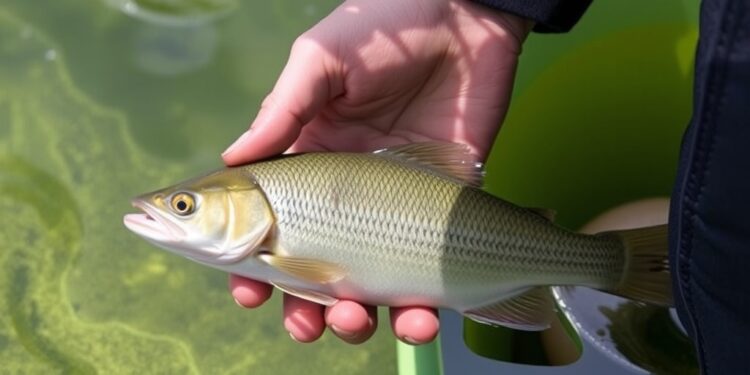A scientific initiative aimed at addressing the ecological threats posed by Prymnesium algal blooms in the Broads region is gaining renewed traction due to a collaborative effort involving prominent institutions and community stakeholders. This renewed partnership consists of the University of East Anglia (UEA), the Environment Agency, the Broads Authority, and local angling enthusiasts from the Norfolk pike community. The significance of this collaborative effort cannot be understated, as it seeks to unravel critical scientific questions about the ecological dynamics surrounding harmful algal blooms and their consequences.
Prymnesium algal blooms, primarily caused by the golden alga Prymnesium parvum, can wreak havoc on aquatic ecosystems, producing potent toxins that are detrimental to fish populations and biodiversity. Such toxic outbreaks threaten not only local fish stocks but also the economic stability of East Anglia’s vibrant angling tourism sector, which generates over £100 million each year. The urgency of this situation has mobilized various stakeholders to invest their time and resources into developing solutions that mitigate the risks associated with these harmful algal blooms.
UEA researchers are at the forefront of this scientific endeavor, embarking on a quest to comprehend the multifaceted environmental, chemical, and biological conditions that can trigger Prymnesium blooms. Their research aims to shine a spotlight on the interplay of these factors in the broader ecosystem. While this long-term investigative project has been in motion for almost ten years, the return of esteemed researcher Professor Rob Field to UEA represents a pivotal moment, signaling an upswing in both momentum and support for this vital work.
The engagement of Norfolk’s angling community has been particularly noteworthy, illustrating a grassroots response to the pressing ecological challenge at hand. The anglers have collectively raised nearly £4,000 to bolster the research efforts and have actively contributed to water sampling activities throughout the Broads National Park. This community involvement serves as an essential reminder of the dual threats posed by environmental degradation and the loss of livelihood for local communities reliant on fishing and angling tourism.
Professor Field, who now serves as the Pro-Vice Chancellor for UEA’s Faculty of Science, expresses the importance of this research not only for ecological health but also for the economic interests tied to the Broads. He emphasizes that through concerted efforts with local anglers and environmental agencies, the research team is making strides toward understanding and intervening in the processes that give rise to harmful algal blooms. The potential implications of this work extend beyond academic interest; they hold practical significance for the preservation of aquatic ecosystems and regional economies.
The research methodology encompasses both laboratory experiments and real-world field studies aimed at pinpointing specific geographic locations that are particularly vulnerable to Prymnesium blooms. Researchers are examining how nutrient concentrations and salinity levels impact the occurrence of these blooms. The complexity of the problem lies in the interactions of various environmental factors, and disentangling these elements is crucial for developing effective mitigation strategies.
John Currie, the Chairman of the Norwich and District Pike Club, has voiced the concerns of local anglers who deeply understand the adverse effects of toxic Prymnesium blooms. Many anglers have witnessed firsthand the destructive impact of these algal outbreaks on aquatic life. Currie’s enthusiasm for the collaborative research effort is palpable; he appreciates the accessibility of world-class scientists dedicated to this specific research area. The passion and dedication of individuals like Currie highlight the critical intersection of community and science in addressing pressing environmental issues.
As the research progresses, stakeholders remain hopeful that the findings will lead to actionable strategies aimed at preserving the waterways of Norfolk and safeguarding its rich ecological heritage. The importance of such strategies extends to the management of fish populations, local fishing practices, and the overall health of the Broads ecosystem. Environmental Policy Adviser Andrea Kelly from the Broads Authority articulates a similar sentiment, expressing delight at the unfolding research that seeks to clarify the triggers of Prymnesium algal blooms. The aim is to protect aquatic life while improving the management of navigation in the region, which is vital for both recreation and local economies.
Recent scientific breakthroughs from collaborations between UEA and the John Innes Centre have shed light on critical aspects of the toxicological properties of Prymnesium parvum. Researchers have gained invaluable insights into the mechanisms governing the timing and conditions under which these algae produce their toxins, as well as the pathways through which toxins are released into aquatic environments. Such revelations could serve as a springboard for innovative management approaches tailored to minimize the risks of harmful algal blooms.
In summary, this ongoing research initiative represents a beacon of hope amid rising ecological challenges. By melding scientific inquiry with community engagement, stakeholders are paving the way for an integrated approach to environmental stewardship. The collaborative nature of this endeavor serves as a powerful reminder that addressing complex environmental issues requires the collective will and expertise of researchers, local communities, and environmental agencies. The road ahead may be fraught with challenges, but together, participants are laying the groundwork for a healthier ecosystem and a more resilient fishing industry in East Anglia.
Understanding Prymnesium algal blooms is more than an academic pursuit; it is a pressing necessity for preserving the balance of ecosystems and the livelihoods tied to them. As scientists continue to delve into the intricacies of these blooms—unraveling their causes and effects—the promise of effective mitigation strategies grows, fostering a sense of hope for both the aquatic environments of the Broads and the communities that depend on them.
Subject of Research: Prymnesium algal blooms and their environmental impact
Article Title: Collaborative Effort Aims to Combat Harmful Algal Blooms in the Broads
News Publication Date: October 2023
Web References: https://research-portal.uea.ac.uk/en/persons/robert-field, https://www.uea.ac.uk/about/faculties-and-schools/faculty-of-science
References: Link to relevant studies and articles on Prymnesium algal blooms to be included here
Image Credits: University of East Anglia
Keywords
Prymnesium, algal blooms, ecological impact, environmental research, community collaboration, University of East Anglia.




